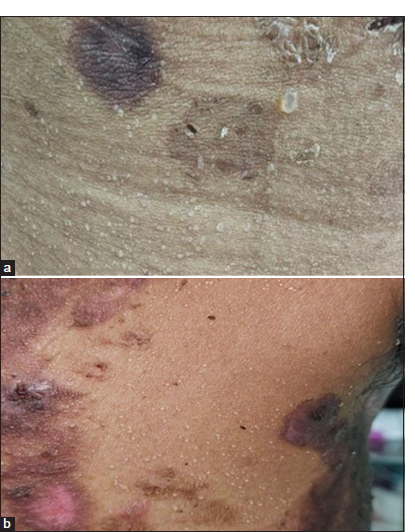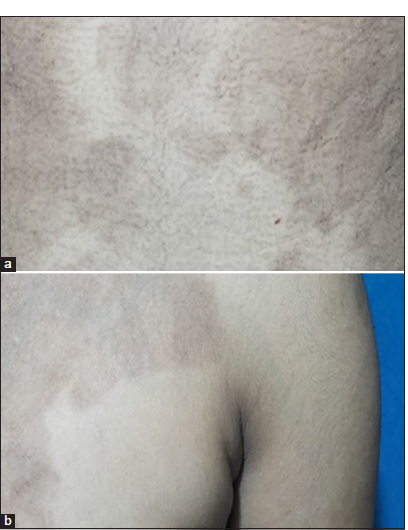Dew Drops Over Skin: A Rare Case of Miliaria Crystallina in an Adult Female with Pemphigus Vulgaris
*Corresponding author: Prachi Sanjay Gaikwad, Department of Dermatology, Venereology and Leprosy, PCMC’s PGI YCM Hospital, Pune, Maharashtra, India. psgaikwad57@gmail.com
-
Received: ,
Accepted: ,
How to cite this article: Gaikwad PS, Palaskar NM, More YE, Gadkar SS. Dew Drops Over Skin: A Rare Case of Miliaria Crystallina in an Adult Female with Pemphigus Vulgaris. Indian J Postgrad Dermatol. 2025;3:49-51. doi: 10.25259/IJPGD_168_2024
Abstract
Miliaria crystallina occurs due to sweat duct obstruction and sweat retention into the stratum corneum. Miliaria is common in infants due to immaturity of eccrine glands. Heat, humidity, fever and a few drugs (e.g., isotretinoin and bethanechol) are known predisposing factors for the development of miliaria. To the best of our knowledge, miliaria has not been reported in patients with pemphigus vulgaris.
Keywords
Eccrine glands
Heat rash
Miliaria crystallina
Sweat retention
INTRODUCTION
Miliaria crystallina, also known as sweat rash or prickly heat, is an asymptomatic condition characterised by sweat retention due to blockage in the eccrine sweat ducts.[1] It is more frequent in infants, neonates and young children, whereas it is less common in adults.[2] Predisposing factors include over-wrapping of clothes, fever, occlusive dressings, lack of air conditioning in warm climates and few drugs.[2] Here, we discuss a rare case of miliaria crystallina in an adult female with pemphigus vulgaris, highlighting its occurrence in an atypical population.
CASE REPORT
A 26-year-old female, biopsy-proven case of pemphigus vulgaris, was admitted to the dermatology ward for dexamethasone cyclophosphamide pulse (DCP), 1st cycle of Phase 1. On 3rd day of DCP, she suddenly developed multiple, tiny, clear fluid-filled vesicles over her trunk. These vesicles were not associated with redness, itching or fever. On examination, there were multiple tiny vesicles of size ranging from 3 to 8 mm in diameter, without surrounding erythema. The lesions were filled with clear fluid and were looking like dew drops discretely distributed over the chest , axillae and lower abdomen [Figure 1]. Tzanck smear from these vesicles was unremarkable. Based on history, clinical examination and Tzanck smear, we concluded that the patient was suffering from miliaria crystallina, also known as heat rash or sudamina. The patient was shifted to a relatively cooler, well-ventilated room. The lesions improved and eventually cleared up on their own by desquamation within 48 h without leaving behind any pigmentation or scarring [Figure 2].

- (a, b) Multiple well-defined pinhead-sized clear fluid vesicles without surrounding erythema present over abdomen and left axilla. Note: Post-inflammatory hyperpigmented macules due to healed lesions of pemphigus vulgaris.

- (a, b) Post-inflammatory hyperpigmented macules due to resolved lesions of pemphigus vulgaris, over abdomen and left axilla with a resolution of miliaria after 2 weeks of follow-up.
DISCUSSION
In humans, there are three main types of sweat glands: eccrine, apocrine and apoeccrine. Amongst these, eccrine glands are the most abundant and present throughout the body.[2] They are mainly stimulated by sympathetic nerves, using cholinergic fibres.[3] Eccrine sweat glands respond primarily to core body temperature and skin temperature, as well as adrenergic activation and exercise-related non-thermal factors.[3]
In miliaria, keratinous plugs block eccrine sweat ducts, trapping sweat and resulting in retrograde pressure. It causes duct rupture, which allows the sweat to seep into dermis and epidermis. Miliaria is of three types based on the depth of the anatomical blockage of the eccrine sweat glands: crystallina, rubra and profunda.[4]
Miliaria crystallina, the most common type, occurs due to blockage at the stratum corneum. Miliaria rubra and profunda occur due to blockage at the subcorneal layers and the dermal-epidermal junction, specifically the papillary dermis respectively.
Miliaria is commonly reported in newborns and critically ill patients with fever in the intensive care unit. Few medications and warm and humid environment are also predisposing factors for miliaria.
In our case, an adult female with pemphigus vulgaris experienced miliaria crystallina, causing her anxiety and worry. She mistakenly believed that the new acute rash was related to her pemphigus vulgaris despite being on treatment.
Viral infections (herpes simplex or varicella), arthropod bites, new lesions of pemphigus vulgaris, acute generalised exanthematous pustulosis, Grover disease and allergic dermatitis should be considered as differential diagnoses of miliaria.[4,5] The absence of erythema around lesions, itching and burning sensation, fever and considering the patient’s age, effectively ruled out these differentials.
CONCLUSION
The association of miliaria crystallina in pemphigus vulgaris has not been previously reported. Our patient did not develop miliaria on subsequent pulses of DCP. Warm and humid climatic conditions were the probable precipitating factors for miliaria in our case.
Ethical approval
Institutional Review Board approval is not required.
Declaration of patient consent
The authors certify that they have obtained all appropriate patient consent.
Conflicts of interest
There are no conflicts of interest.
Use of artificial intelligence (AI)-assisted technology for manuscript preparation
The authors confirm that there was no use of artificial intelligence (AI)-assisted technology for assisting in the writing or editing of the manuscript and no images were manipulated using AI.
Financial support and sponsorship:
Nil.
References
- Widespread Miliaria Crystallina: About a Case. Pan Afr Med J. 2018;30:69.
- [CrossRef] [Google Scholar]
- Water Drops All Over the Skin: Miliaria Crystallina in an Adult Febrile Patient with Glioblastoma. Maedica. 2023;18:534.
- [CrossRef] [PubMed] [Google Scholar]
- Mechanisms and Controllers of Eccrine Sweating in Humans. Front Biosci (Schol Ed). 2010;2:685.
- [CrossRef] [PubMed] [Google Scholar]
- An Unusual Presentation of Heat Rash: Bullous Miliaria in a Middle-aged Woman. Cureus. 2022;14:e25323.
- [CrossRef] [PubMed] [Google Scholar]







